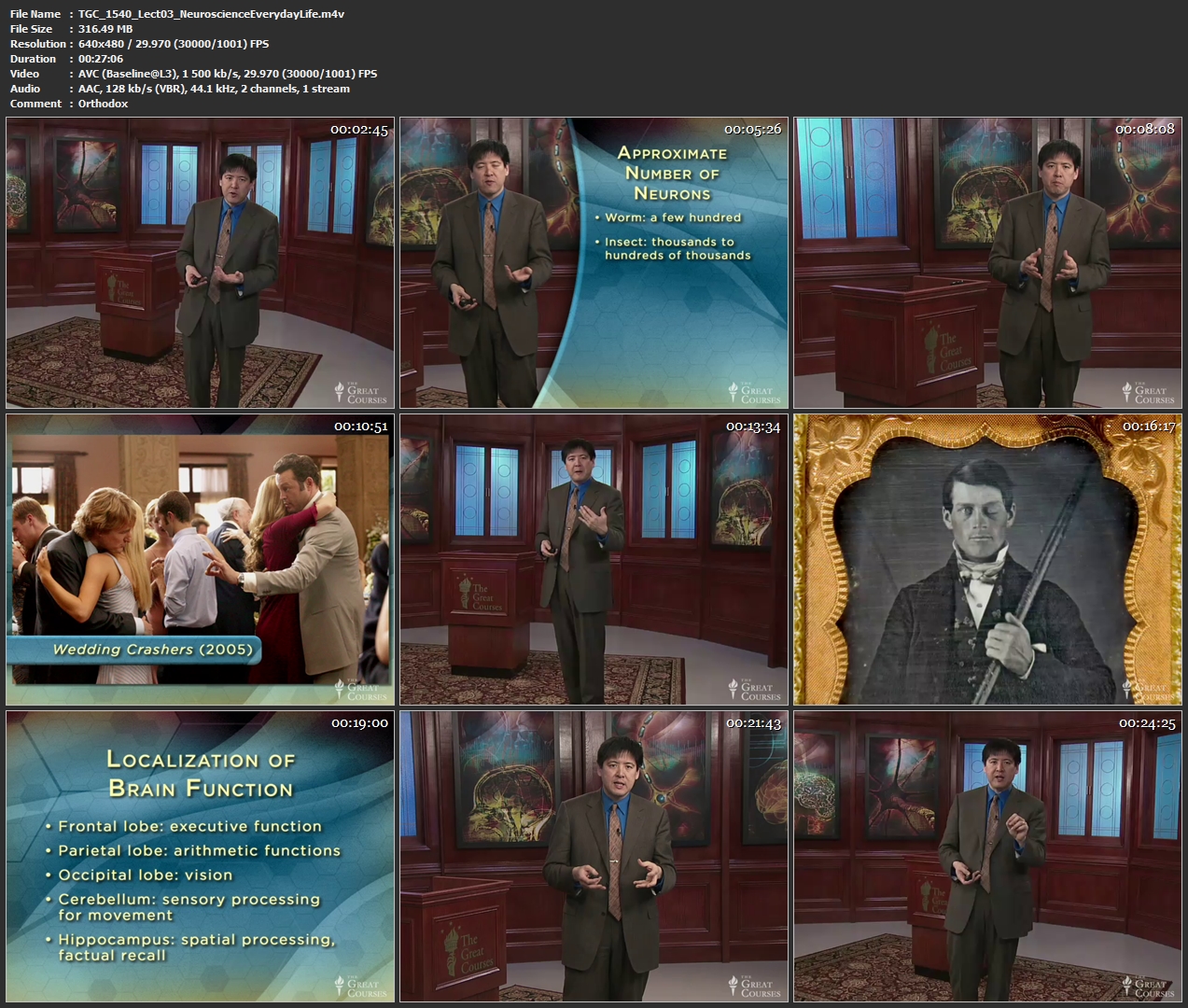TGC - Neuroscience of Everyday Life
Professor Sam Wang, Ph.D. | Video: m4v Video 640x480 | Audio: AAC 44KHz | Duration: 18:01 Hours | Lec: 36 - Average 30 minutes each | 12.3 GB | Language: English + Guidebook {PDF}
Your nervous system is you. All the thoughts, perceptions, moods, passions, and dreams that make you an active, sentient being are the work of this amazing network of cells. For many centuries, people knew that this was true. But no one was sure how it happened.
Description
Now, thanks to the exciting new field of neuroscience, we can chart the workings of the brain and the rest of the nervous system in remarkable detail to explain how neurons, synapses, neurotransmitters, and other biological processes produce all the experiences of everyday life, in every stage of life. From the spectacular growth of the brain in infancy to the act of learning a skill, falling in love, getting a joke, revising an opinion, or even forgetting a name, something very intriguing is going on behind the scenes.
For example, groundbreaking research in the past few decades is now able to explain such phenomena as these:
Decisions: Studies of decision making at the level of neurons show that our brain has often committed to a course of action before we are aware of having made a decision-an apparent violation of our sense of free will.
Memory: Memory is composed of many systems located in different parts of the brain, which means that you can forget your car keys (information stored in the neocortex) but still remember how to drive (a learned skill requiring the striatum and cerebellum).
Willpower: Willpower is more than a metaphor; it's a measurable trait that draws on a finite mental resource, like a muscle. While any given individual has a consistent willpower capacity throughout life, it can be strengthened through training-again, just like a muscle.
Religion and spirituality: Three mental traits appear to be essential for the development of organized religion: the search for causes and effects, the ability to reason about people and motives, and language. Mystical experiences also trace to specific activities of the brain.
Opening your eyes to how neural processes produce the familiar features of human existence, The Neuroscience of Everyday Life covers a remarkable range of subjects in 36 richly detailed lectures. You will explore the brain under stress and in love, learning, sleeping, thinking, hallucinating, and just looking around-which is less about recording reality than creating illusions that allow us to function in our environment.
Your professor is distinguished neuroscientist and Professor Sam Wang of Princeton University, an award-winning researcher and best-selling author, public speaker, and TV and radio commentator. Professor Wang's insightful and playful approach makes this course a joy for anyone who wants to know how his or her own brain works. And his vivid, richly illustrated presentation assumes no background in science.
Fact or Fiction?
Professor Wang points out that a lot of what we think we know about our brains turns out to be wrong. While bringing you up to date on the latest discoveries in the field, he debunks the following persistent myths:
We use only 10% of our brains: Your brain is actually running at 100%! The myth about idle brain power has been promoted by self-help gurus and doesn't stand up to evidence from cases of brain damage, which always cause deficits in function.
Mozart makes babies smarter: Playing classical music may help calm you down around an infant, but it's not doing anything for the baby. The better strategy is to have children learn to play a musical instrument when they're older, which does improve brain development.
Women are moodier than men: Studies show that the sexes are tied in the moodiness contest, with men reporting just as frequent mood swings as women. However, both men and women tend to remember women's mood swings better.
We lose brain cells as we age: The brain is supposedly unique as an organ because it stops adding new cells after birth. In fact, some parts of the brain keep producing new neurons throughout life. The brain shrinks somewhat with age, but its neurons live on.
Homepage
Code:https://www.thegreatcourses.com/courses/neuroscience-of-everyday-life.html
Code:https://nitroflare.com/view/E5EBE784FD03BA6/Neuroscience_of_Everyday_Life.part01.rar https://nitroflare.com/view/96B99D2FC53799C/Neuroscience_of_Everyday_Life.part02.rar https://nitroflare.com/view/5A809AE5CDA69CC/Neuroscience_of_Everyday_Life.part03.rar https://nitroflare.com/view/825E16BF95C795D/Neuroscience_of_Everyday_Life.part04.rar https://nitroflare.com/view/F75670434E45BFF/Neuroscience_of_Everyday_Life.part05.rar https://nitroflare.com/view/551E2B8ACC07675/Neuroscience_of_Everyday_Life.part06.rar https://nitroflare.com/view/477C1CC25A9F45B/Neuroscience_of_Everyday_Life.part07.rar https://nitroflare.com/view/F337EA3DE228CC2/Neuroscience_of_Everyday_Life.part08.rar https://nitroflare.com/view/13E37594592CDD0/Neuroscience_of_Everyday_Life.part09.rar https://nitroflare.com/view/5731D5DE67EA643/Neuroscience_of_Everyday_Life.part10.rar https://nitroflare.com/view/ED83BB6373C8EB8/Neuroscience_of_Everyday_Life.part11.rar https://nitroflare.com/view/77989909045872D/Neuroscience_of_Everyday_Life.part12.rar https://nitroflare.com/view/7243B1DAC25F45D/Neuroscience_of_Everyday_Life.part13.rarCode:https://rapidgator.net/file/d137444976bf3e5e028259402bfbe497/Neuroscience_of_Everyday_Life.part01.rar.html https://rapidgator.net/file/595f453e2157e1ff61556fa902249d1e/Neuroscience_of_Everyday_Life.part02.rar.html https://rapidgator.net/file/8af5c0a031f6718aa69299e5ef570449/Neuroscience_of_Everyday_Life.part03.rar.html https://rapidgator.net/file/45db6c121f29d885c01c827ae0da1eeb/Neuroscience_of_Everyday_Life.part04.rar.html https://rapidgator.net/file/b75d71777f00e4b15aac30def0ae15f1/Neuroscience_of_Everyday_Life.part05.rar.html https://rapidgator.net/file/2b3b03efda4e3ec75bcbb1b88dd0f0f4/Neuroscience_of_Everyday_Life.part06.rar.html https://rapidgator.net/file/970b488e7066341456c440b28461d3d0/Neuroscience_of_Everyday_Life.part07.rar.html https://rapidgator.net/file/e4dc37b9990c3c52c789244aa5a0d1cf/Neuroscience_of_Everyday_Life.part08.rar.html https://rapidgator.net/file/f3d29f28cf5f163fcce6afe9f9545099/Neuroscience_of_Everyday_Life.part09.rar.html https://rapidgator.net/file/309f4be1604e76827eb4c8d30a8ef791/Neuroscience_of_Everyday_Life.part10.rar.html https://rapidgator.net/file/9c651e2051cbd48bcdf15e08fd8ba397/Neuroscience_of_Everyday_Life.part11.rar.html https://rapidgator.net/file/e7cb2fdc3184b583c47657ec78a69e90/Neuroscience_of_Everyday_Life.part12.rar.html https://rapidgator.net/file/100f3336a589a032fb7ccef03f3a8472/Neuroscience_of_Everyday_Life.part13.rar.html

 Our Live Cams
Our Live Cams





 Reply With Quote
Reply With Quote